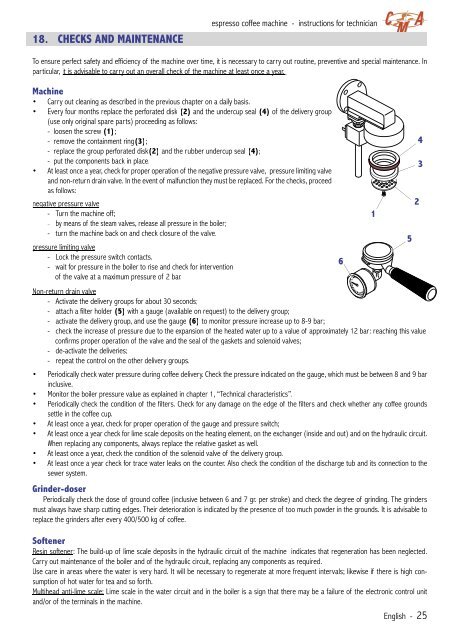CMA Technical Manual - Love Coffee Machines
CMA Technical Manual - Love Coffee Machines
CMA Technical Manual - Love Coffee Machines
Create successful ePaper yourself
Turn your PDF publications into a flip-book with our unique Google optimized e-Paper software.
18. CHECKS AND MAINTENANCE<br />
negative pressure valve<br />
- Turn the machine off;<br />
- by means of the steam valves, release all pressure in the boiler;<br />
- turn the machine back on and check closure of the valve.<br />
pressure limiting valve<br />
- Lock the pressure switch contacts.<br />
- wait for pressure in the boiler to rise and check for intervention<br />
of the valve at a maximum pressure of 2 bar.<br />
espresso coffee machine - instructions for technician<br />
To ensure perfect safety and efficiency of the machine over time, it is necessary to carry out routine, preventive and special maintenance. In<br />
particular, it is advisable to carry out an overall check of the machine at least once a year.<br />
Machine<br />
• Carry out cleaning as described in the previous chapter on a daily basis.<br />
• Every four months replace the perforated disk (2) and the undercup seal (4) of the delivery group<br />
(use only original spare parts) proceeding as follows:<br />
- loosen the screw (1);<br />
- remove the containment ring(3);<br />
- replace the group perforated disk(2) and the rubber undercup seal (4);<br />
- put the components back in place.<br />
• At least once a year, check for proper operation of the negative pressure valve, pressure limiting valve<br />
and non-return drain valve. In the event of malfunction they must be replaced. For the checks, proceed<br />
as follows:<br />
Non-return drain valve<br />
- Activate the delivery groups for about 30 seconds;<br />
- attach a filter holder (5) with a gauge (available on request) to the delivery group;<br />
- activate the delivery group, and use the gauge (6) to monitor pressure increase up to 8-9 bar;<br />
- check the increase of pressure due to the expansion of the heated water up to a value of approximately 12 bar: reaching this value<br />
confirms proper operation of the valve and the seal of the gaskets and solenoid valves;<br />
- de-activate the deliveries;<br />
- repeat the control on the other delivery groups.<br />
• Periodically check water pressure during coffee delivery. Check the pressure indicated on the gauge, which must be between 8 and 9 bar<br />
inclusive.<br />
• Monitor the boiler pressure value as explained in chapter 1, “<strong>Technical</strong> characteristics”.<br />
• Periodically check the condition of the filters. Check for any damage on the edge of the filters and check whether any coffee grounds<br />
settle in the coffee cup.<br />
• At least once a year, check for proper operation of the gauge and pressure switch;<br />
• At least once a year check for lime scale deposits on the heating element, on the exchanger (inside and out) and on the hydraulic circuit.<br />
When replacing any components, always replace the relative gasket as well.<br />
• At least once a year, check the condition of the solenoid valve of the delivery group.<br />
• At least once a year check for trace water leaks on the counter. Also check the condition of the discharge tub and its connection to the<br />
sewer system.<br />
Grinder-doser<br />
Periodically check the dose of ground coffee (inclusive between 6 and 7 gr. per stroke) and check the degree of grinding. The grinders<br />
must always have sharp cutting edges. Their deterioration is indicated by the presence of too much powder in the grounds. It is advisable to<br />
replace the grinders after every 400/500 kg of coffee.<br />
Softener<br />
Resin softener: The build-up of lime scale deposits in the hydraulic circuit of the machine indicates that regeneration has been neglected.<br />
Carry out maintenance of the boiler and of the hydraulic circuit, replacing any components as required.<br />
Use care in areas where the water is very hard. It will be necessary to regenerate at more frequent intervals; likewise if there is high consumption<br />
of hot water for tea and so forth.<br />
Multihead anti-lime scale: Lime scale in the water circuit and in the boiler is a sign that there may be a failure of the electronic control unit<br />
and/or of the terminals in the machine.<br />
English - 25<br />
6<br />
1<br />
R<br />
5<br />
4<br />
2<br />
3



